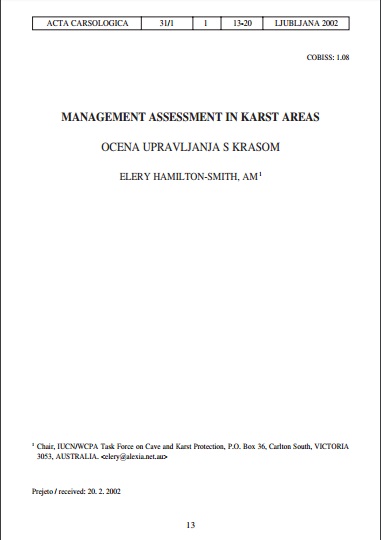Management Assessment in Karst Areas
DOI:
https://doi.org/10.3986/ac.v31i1.400Povzetek
Najpomembnejša odgovornost pri upravljanju s svetovno dediščino je dvojna. Po eni strani bi morali ohraniti integriteto in kakovost naravnega okolja, po drugi pa omogočiti dostop čim širši javnosti. Čeprav je v tej trditvi morda nekaj dvoumnosti pa ni dvoma, da se osnovna elementa tega vprašanja dopolnjujeta in da enega ni mogoče v celoti rešiti, ne da bi upoštevali tudi drugega. To vodi do ključnega vprašanja, ali je upravljalec sposoben odgovorno izvajati svoja pooblastila. Prispevek podaja pregled in ocene različnih splošnih pristopov k upravljanju, ki so bili oziroma bi lahko bili uporabljeni. To vključuje različne sheme nadzora nad vplivom obiskovalcev, v glavnem iz ZDA; gre za trojni (okoljski/družbeni/ekonomski) trajnostni pristop in tveganja pri upravljalski strategiji. Sklep prispevka je, da mora upravljalec vsakega kraškega področja razviti sprotno se dopolnjujoč načrt upravljanja, ki mora vključevati tako dolgoročne in načelne rešitve, obenem pa se mora ukvarjati tudi s posebnimi izzivi, ki so tipični le v lokalnem okviru. Vsak pristop, o katerem je govora v tem prispevku, lahko pomaga pri pripravi kateregakoli načrta upravljanja.
The key management responsibility in World Heritage Areas is a two-fold one of preserving environmental integrity and quality while at the same time providing for broad-scale public access. Although there is some mbiguity in this mandate, there is no question that these two elements of management are complementary, and that one cannot fully assess one without consideration of the other. This leads to the key question of how management is able to meet the responsibility of this mandate. This paper reviews and assesses various conceptual approaches that have been or might be utilised. These include various visitor impact control schemes generally of U.S. origin; the three faceted (environmental /social /economic) sustainability approach and risk management strategies. This paper concludes that each karst area management agency must develop an ongoing assessment plan that both deals with broad-scale issues while also meeting the distinctive challenges which are endemic to their own situation. Any of the approaches discussed may make a contribution to any one such plan.
Prenosi

Prenosi
Objavljeno
Kako citirati
Številka
Rubrike
Licenca
Avtorji jamčijo, da je delo njihova avtorska stvaritev, da v njem niso kršene avtorske pravice tretjih oseb ali kake druge pravice. V primeru zahtevkov tretjih oseb se avtorji zavezujejo, da bodo varovali interese založnika ter da bodo povrnili morebitno škodo.
Podrobneje v rubriki: Prispevki




